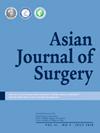新生儿和12个月以下婴儿的机器人手术:可行吗?
IF 3.8
3区 医学
Q1 SURGERY
引用次数: 0
摘要
与成人相比,机器人手术在儿科患者中存在一些困难,例如由于儿童体型小,导致工作空间减少,导致蛀牙减少。这一局限性限制了这种方法在新生儿和婴儿患者中的应用。我们对前100例连续接受机器人手术的12个月以下儿童进行了回顾性回顾。方法对2010年至2020年期间连续接受机器人手术的12个月以下儿童进行了回顾性单中心研究。使用一个三臂机器人(5毫米套管)和一个12毫米相机臂。分析人口统计学资料、机器人手术类型、手术时间和术后并发症。结果共纳入100例患者(男51例,女49例),手术时中位年龄5个月(IQR: 3-8个月),平均体重6.2±1.9 kg。我们进行了147例机器人辅助手术:66例复底术,43例胃造口术,19例牵引术,8例幽门成形术,3例先天性膈疝修补术,2例肾切除术,1例肾上腺肿瘤,1例肝囊肿,1例纵隔囊肿,1例胆总管囊肿,1例肠重复囊肿和1例Ladd手术。中位手术时间为130 min,不同手术方式间有一定差异(IQR: 103 ~ 202 min)。没有术中并发症或转换为开放或腹腔镜技术的描述。术后出现并发症6例(2例需再次手术)。在长期随访期间(中位6.5年;IQR 3.8-9.4),我们报告了4%的再干预。结论虽然机器人手术在新生儿和婴儿中仍存在争议,但由训练有素的外科医生进行手术是可行和安全的,并发症发生率极低。证据水平:本文章由计算机程序翻译,如有差异,请以英文原文为准。
Robotic surgery in newborns and infants under 12-months: Is it feasible?
Introduction
Robotic surgery in pediatric patients has some difficulties compared to adults, such as reduced cavities due to children's small size that lead to decreased working space. This limitation has restricted this type of approach in newborn and infant patients. We present a retrospective review of our first 100 consecutive robotic cases in children under 12-months
Methods
A retrospective single-center study was performed among consecutive children under 12-months who underwent robotic surgeries between 2010 and 2020. A three-arm robot (5-mm trocars) with one 12-mm camera arm was used. Demographic data, type of robotic procedure, surgery time and postoperative complications were analyzed.
Results
A total of 100 patients were included (51 males; 49 females), with a median age of 5 months at surgery (IQR: 3–8 months) and a mean weight of 6.2 ± 1.9 kg. We performed 147 robotic-assisted procedures: 66 fundoplications, 43 gastrostomies, 19 pull-throughs, 8 pyloroplasties, 3 congenital diaphragmatic hernia repairs, 2 nephrectomies, 1 adrenal tumor, 1 liver cyst, 1 mediastinal cyst, 1 common bile duct cyst, 1 intestinal duplication cyst and 1 Ladd's procedure. Median surgery time was 130 min with some differences among different procedures (IQR: 103–202 min). No intraoperative complications or conversion to open or laparoscopic technique were described. Postoperative complications were found in 6 patients (2 required reoperation). During long-term follow-up (median 6.5 years; IQR 3.8–9.4), we reported 4 % of reintervention.
Conclusion
Although robotic surgery in newborns and infants are still controversial, it is feasible and safe to perform by well-trained surgeons, with a very low complication rate.
Level of evidence
IV.
求助全文
通过发布文献求助,成功后即可免费获取论文全文。
去求助
来源期刊

Asian Journal of Surgery
医学-外科
CiteScore
3.60
自引率
31.40%
发文量
1589
审稿时长
33 days
期刊介绍:
Asian Journal of Surgery, launched in 1978, is the official peer-reviewed open access journal of the Asian Surgical Association, the Taiwan Robotic Surgery Association, and the Taiwan Society of Coloproctology. The Journal is published monthly by Elsevier and is indexed in SCIE, Medline, ScienceDirect, Scopus, Embase, Current Contents, PubMed, Current Abstracts, BioEngineering Abstracts, SIIC Data Bases, CAB Abstracts, and CAB Health.
ASJSUR has a growing reputation as an important medium for the dissemination of cutting-edge developments in surgery and its related disciplines in the Asia-Pacific region and beyond. Studies on state-of-the-art surgical innovations across the entire spectrum of clinical and experimental surgery are particularly welcome.
The journal publishes original articles, review articles, and case reports that are of exceptional and unique importance. The journal publishes original articles, review articles, and case reports that are of exceptional and unique importance.
 求助内容:
求助内容: 应助结果提醒方式:
应助结果提醒方式:


